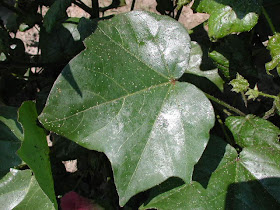 |
| Aphids |
 |
| Aphid Honeydew on Ivy |
Sitting in my backyard has become an unpleasant experience. I have lots of deciduous trees and they all seem to have a large crop of aphids. One evening as I looked toward the sun, I could see the aphid “honeydew” (poop actually) pouring down like a gentle rain! When I come in from outside, I feel as if I am covered with aphids! Is there a variety that feeds on humans?
We are also on an irrigation ditch which is host to dozens of lovely cottonwoods. I like the cottonwood, but it is certainly the messiest tree ever. This time of year, the cotton is flying and sticking to the aphid honeydew that covers everything. Only a power washer can clean off the deck!
It seemed to me that the aphids are more numerous than previous years so I consulted Dr. Whitney Cranshaw, Entomology Professor and Extension Specialist at CSU, and he verified my suspicions. Here’s what he had to say.
“The northern Front Range is seeing a surge of aphids, and has for a couple of weeks.
This is due to the cool spring, followed (most importantly) by the repeatedly rainfall events. The former (cool temperatures) have the effective of retarding the activity of aphid natural enemies. The latter (moisture) promotes the flush of new growth that is favored by many aphids. And all manner of plants have had some aphid problems, each (pretty much) having their own species of aphid associate. (There are over 350 species of aphids in CO.)
 |
| Lady Bug Larvae |
That all this is going on so late is due to the cool spring. I think the insects are at least 2 weeks, perhaps more, behind schedule this year.”
Sure enough, last evening while my family sat on the deck, we saw numerous lady bug and lacewing larvae crawling on chair covers, (and us!) While it is tempting to spray something, I will follow Dr. Cranshaw’s advice and let Mother Nature take her course. It is, however, disconcerting coming in from a day of gardening knowing that not only am I showering off a day’s worth of sweat and garden dirt, but also, the cycle of life from one insect’s perspective: aphids, aphid poop, and aphid predators!
Here’s a complete fact sheet on aphids.
